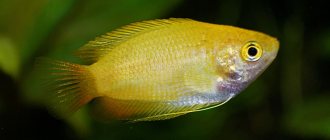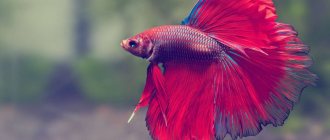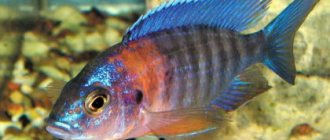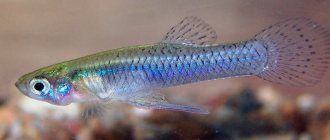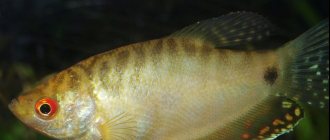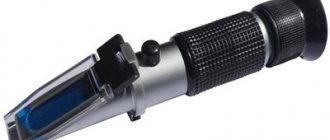Depending on the type of reproduction, fish are divided into egg-laying, ovoviviparous, and viviparous.
Egg-laying fish are the main group of fish that spawn eggs into the water column, where fertilization occurs.
Ovoviviparous - internal fertilization, the embryo develops in the female’s body in special extensions of the oviducts, but is nourished by the nutrients of the yolk sac, and the mother’s body serves only as protection from external factors.
Viviparous - in these fish, the union of the egg and sperm occurs in the female’s genital tract, the formation of the placenta occurs, which ensures the connection of the mother’s body with the embryo and supplies nutrients.
Viviparity is a rare phenomenon, typical for aquarium fish (guppies, swordtails), and sharks. There is no larval stage; an embryo develops in the oviducts of the female, and an already formed fry is born, which is capable of independent existence.
The process of development of an adult fish from an egg
The nuances of breeding aquarium fish
One of the rewarding but challenging aspects of aquarium keeping is fish breeding. The first attempts, as a rule, are unsuccessful, because you need to accumulate certain knowledge and experience so that in the future everything goes smoothly.
An aquarist must know how to properly breed fish of a particular species.
All aquarium fish according to the method of reproduction are divided into:
- spawning;
- viviparous.
Caviar on the walls of the aquarium
Egg-laying species
Such fish have external fertilization, in which the female lays hundreds/thousands of eggs, and the male simultaneously releases the seed. This method is unsystematic, and therefore it is not surprising that a significant part of the eggs remains unfertilized. If the couple at this moment presses against each other, as if hugging fins, then the chances increase. During the short incubation period (about 36 hours), the eggs are in serious danger - they can be eaten. Therefore, some species have developed protective mechanisms.
Carp-toothed spawners. Killifish
On a note ! Some fish spawn in hard-to-reach places (for example, the underside of leaves, empty shells, caves), others themselves protect them from strangers, and still others keep the eggs in their mouths (sometimes they even hide the babies there).
Scheme of spawning of spawning fish
Viviparous species
In such fish, the eggs are fertilized inside the female's body, due to which the fry are born fully formed. The seed is introduced by the male using a tube-shaped anal fin (gonopodium). During mating, the seed enters the female’s body in portions, in a kind of “package,” which subsequently dissolves in 15 minutes. What is characteristic is that the sperm that remains after fertilization does not die, as in mammals, but remains viable throughout the life of the female. It turns out that a female can save seed from several males at once and use it in the future for reproduction.
The offspring of viviparous fish are born fully formed
This method of reproduction ensures a higher survival rate of fry when compared with egg-laying species, since the incubation period of eggs - the most dangerous - passes in relative safety.
Note ! It is worth knowing that parental instinct is absent in almost all viviparous fish, and therefore the young may well become food for their own parents.
Livebearers
Distinctive features of pregnant female guppies
Knowing how long pregnancy lasts, you can roughly calculate the time of appearance of the offspring and prepare a separate container for the fry, buy the necessary food so that everything is prepared for the reception of the young. You should not place your pet in advance: for a schooling fish, loneliness is a strong stress, so it is transferred to the spawning tank only in the last 1-2 days before giving birth. You can find a sign whether a female is pregnant by her appearance and changes in behavior.
Pregnancy period
As the eggs develop, the abdomen of the aquarium fish also increases. It becomes more convex and rounded than between breeding periods.
With careful observation, you can also detect changes in the behavior of fish during pregnancy. The female shows aggressiveness, not allowing males to approach her and not responding to their advances. A fertilized fish will not need a male for several months, and it reacts to the opposite sex as if it were food competitors.
While pregnancy lasts, the fish feeds more actively, absorbs more food and can fight with other inhabitants, taking food from them. The reason for this behavior is the increased need for nutrients during the period of maturation of eggs and growth of fry in them.
When the pregnancy period comes to an end, the rounded abdomen acquires an angular outline. On the posterior edge of the abdomen in light-colored fish a dark spot appears, which by the time of birth occupies approximately ¼ of the entire convex part of the body.
When to place guppies for birth?
The guppy's behavior changes again before giving birth, and this makes it possible to determine when it needs to be transplanted into a spawning pond. 24-48 hours before birth, the fish becomes slow, stops eating and tries to hide in the thickets of plants. At this time, it is advisable to plant it in a previously prepared container. The basic requirements for the spawning tank are as follows:
- the water must be settled and well aerated;
- during transplantation, its temperature is equal to the temperature in the general aquarium, but after transplantation it must be gradually raised to +27...+29°C;
- this temperature must be maintained as long as the fry grow before being transferred to a common reservoir (2-3 months after birth);
- small-leaved plants (elodea, hornwort, cabomba, floating richia, etc.) should be placed in the pond, but free space should be left;
- sand on the bottom is not needed, it is easier to remove the remains of the fry’s vital activity;
- reservoir depth - about 20 cm;
- volume - approximately 10 liters.
If there is enough oxygen in the aquarium, the female may sink to the bottom before giving birth. If it catches air on the surface of the water, aeration needs to be increased or the water temperature slightly reduced. You should not feed the fish in the spawning area, so as not to pollute the water with food debris.
Childbirth
The process occurs most often at night, so monitoring the pet is complicated by late hours. But if you can’t wait for the right moment, watch how the fish reproduce in videos made by amateurs.
The fry appear fully formed and immediately begin to swim, hiding in the thickets of plants. If the egg is slightly immature, the guppy may give birth to a fry in a shell, which it will tear apart on its own. This rarely happens, and the appearance of a large number of such young animals indicates errors in the diet or too warm water.
After about 30-40 minutes (this is how long labor lasts for viviparous fish), the female must be removed from the spawning aquarium. If this is not done, hungry spawning fish will eat the newborn fry.
How often do guppies give birth?
Knowing how long pregnancy lasts, you can calculate the frequency of obtaining offspring from 1 fish. The average gestation period for eggs is 35-45 days. Fluctuations in duration depend on water temperature: in warm weather, eggs mature faster, but a sharp increase in temperature can lead to the birth of immature eggs with underdeveloped fry.
Soon after the end of labor, the female may become pregnant again. When calculating the frequency of appearance of fry in 1 fish, one should take into account the approximate period of egg development and add 1-2 weeks for the period between spawnings. Therefore, 1 female gives birth approximately once every 2 months.
The onset of puberty occurs at 3-4 months of age. From this time on, the fish can already give birth to offspring. There are myths among aquarists that the fish fertilizes itself. This is not true: she needs a male, but she can bring offspring 6-8 times without his participation after 1 intercourse. If fertilization occurred when the fish were kept in a general aquarium at a pet store, then after purchasing a female, the new owner can observe an interesting effect: females reproduce without the presence of males in the school.
Details about how fish reproduce are necessary for a breeder who decides to get offspring from a purebred male. A newly acquired female guppy should be kept in a separate pond for 2-3 months. If she does not bring fry, then you can add the partner you need for breeding to her.
How many fry will be born?
How many fry 1 female gives birth to depends on her age and size. A young or medium-sized fish can produce 15-20 pieces, and in older individuals the number of offspring reaches 100 pieces. But not all the numbers that are born can grow to adulthood: fry in a community aquarium quickly become food for larger fish. In the spawning tank, they need to create conditions for growth and development so that they become beautiful fish.
How to get offspring of aquarium fish?
This can be done in the only possible way - by placing a sexually mature female and male in the same aquarium. In species that have clearly defined sexual dimorphism, male/female identification can be made without problems: males are larger in size and have brighter colors (this includes cichlids, Killy fish, and others). But in other species (some cyprinids, characins), it is much more difficult to visually distinguish a female from a male; differences can only appear during spawning (and even then not in all cases). Therefore, in order to guarantee spawning, we recommend buying at least 5 individuals - in such a group there will definitely be at least 1 male or female.
Killy fish
To guarantee future offspring in most species of fish, it is enough to simply keep a mature female and male together. But in some species, partner selection is a long and very important process. Such fish will not mate with the first male they encounter for reasons known only to them. Such fish include, for example, discus fish, which, having created a pair once, remain faithful until the end of their lives. If you want to breed fish of these species, then it is better to purchase an already formed pair or, as an option, a group of at least 6 individuals that will grow up together (they will probably form at least one suitable pair).
Such affectionate relationships have their opposites - first of all, these are the African cichlids of Malawi and Tanganyika. Like most fish, cichlids are not picky in choosing a partner, but during the spawning period, males begin a tireless pursuit of females, which is accompanied by a rough urge to mate. If a female individual is not yet ready and does not have the opportunity to hide, the consequences can be very serious - even death. At home, you need to place the female in a separate tank so that she has time to recover and become ready to spawn.
Examples of parallel evolution of cichlids in three large African lakes
On a note ! In territorial fish that spawn in groups or pairs, the female is first placed in the spawning aquarium, and only a few days later the male is placed.
What kind of development do fish have: direct or indirect?
Indirect development occurs in larvae, which, when emerging from the egg, do not resemble the adult. Such organisms develop gradually, acquiring the characteristics of their parents through a series of successive stages, differing in their mode of nutrition and lifestyle.
After the eggs ripen, a larva emerges from it, with undeveloped fins and scales, and in appearance it is not similar to the adult. Therefore, such fish belong to organisms with an indirect type of development (mainly bony fish).
When babies are born that are similar to adult organisms, only smaller in size and with incompletely formed organs, such development is called direct. Thus, fish that are characterized by viviparity (for example, sharks) develop in a direct way.
Reproduction of viviparous fish at home
Breeding livebearers is not difficult; even a novice aquarist can handle it. An adult can produce up to 200 fry. Puberty occurs at the age of 3-4 months, and the process of birth of fry looks like this:
- eggs are born in the female’s body;
- the male fertilizes her;
- eggs form and mature inside the female;
- Some fish are born, rushing to the surface to fill their swim bladder with air. The other part remains in the abdomen and is born over the next 6 months.
Note ! A sign that the fish will soon give birth to fry is a rounded belly and a darkened anus.
How does a male livebearer differ from a female?
How to determine whether fish are ready to reproduce
Everything is individual here. Some species, such as gambusia, are ready to give birth 1-2 months after their birth. Others will take 15-30 years to reach sexual maturity. The timing of ripening is affected by:
- life cycle: the shorter it is, the earlier the maturation, and vice versa;
- species affiliation;
- living conditions and climate.
If a fish has a “nuptial outfit”, it means it is ready to give birth to offspring. This may be a bright color, age spots, skin growth, etc.
You can identify female representatives of the carp and characin families that are ready for spawning by looking at their abdomen - when it is filled with eggs, it becomes round and full, even if the fish is hungry.
Here are a couple more interesting facts:
- Males reach sexual maturity earlier than females.
- In young fish, the first few spawnings are unproductive.
A male cockerel takes care of the nest.
Fish instincts
Fertilization is preceded by a series of events. They are a signal of readiness to reproduce.
Stimulation for mating
Many species approach reproduction very responsibly. Salmonids, for example, migrate from the salty ocean up to freshwater bodies to spawn. They can travel thousands of kilometers, making a dangerous journey up fast rivers, exhausting themselves to the end.
In many cases, males (such as guppies) are brightly colored to attract the female. In a mating dance, they circle around the gray females, trying to attract their attention. The lady will choose which male is the most colorful.
Males of other species can build “houses” from silt, mud and other bottom debris. If the female likes the house, the fish mate.
Changes to terms and conditions
Fish, like other living organisms, are subject to biological cycles. Mating occurs under certain conditions that occur with the change of season:
- change in daylight hours;
- change in water temperature (to be more precise, its increase);
- increasing the volume of food (fry need to eat a lot, for example, daphnia and single-celled organisms);
- increasing the concentration of oxygen dissolved in water.
The duration of gestation of eggs depends on the type of fish and can range from 12 hours to one and a half months. The age at which fish reach sexual maturity also varies greatly (from several months to 15-30 years). This depends on the species size and habitat conditions. The smaller the fish, the faster it reproduces and the faster it reaches maturity.
The most famous way of breeding fish is by throwing the game. But some fish reproduce by producing independent fry.
